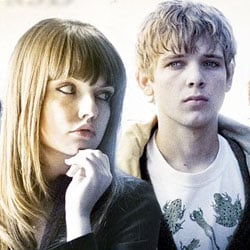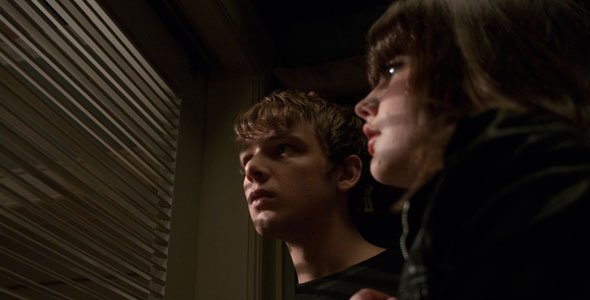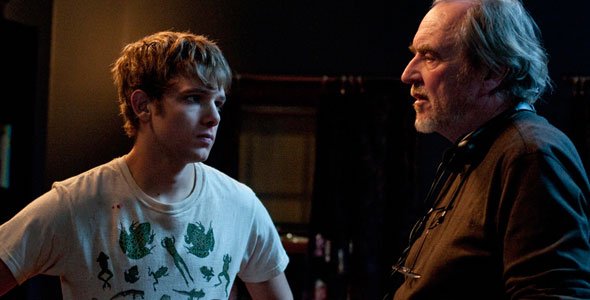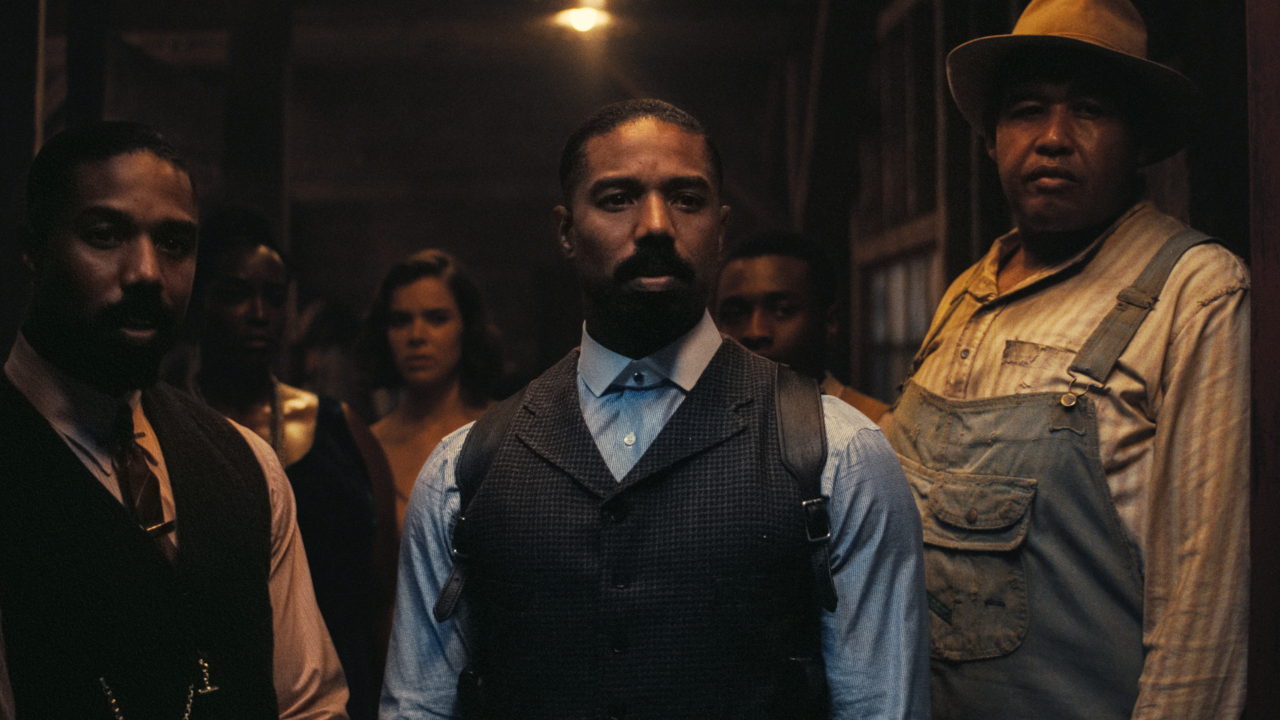Interview: My Soul to Take's Max Thieriot And Emily Meade

We generally know how it works with horror movies nowadays; studios snatch up lesser-known actors and look forward to reaping the benefits. Whether or not that actor makes it past that movie and moves onto having a stable career is beside the point. However, that’s not nearly the case with My Soul to Take’s Max Thieriot and Emily Meade. Not only have both appeared in a number of films, Thieriot starred in his first feature when he was just 16 and Meade recently appeared in Joel Schumacher’s Twelve. But these two aren’t just in any old horror flick; they’re in a Wes Craven movie.
Thieriot stars as Bug, one of seven kids born on the night the infamous Riverton Ripper died. Rumor has it that the Ripper died, but his soul was passed on to one of the seven. Which one? Nobody knows. Meade comes in as Fang, the toughest high school bully of them all. She’s got an upper hand on just about everyone and takes pride in ordering her minions to administer necessary retribution in the form of physical beat downs. Her favorite victim is Bug. However, that relationship is going to have to change because when the Ripper returns and starts claiming the lives of the Riverton seven one-by-one, they’re forced to rely on each other to survive.
Both Thieriot and Meade participated in a roundtable interview and spilled their guts not only on working on My Soul to Take with Craven, but on their experience with the horror genre dating way back to when they were young and on Thieriot’s upcoming film House at the End of the Street. Check that out and more below and be sure to keep an eye out for our exclusive interview with Craven later this week.
Max, what kind of direction did Wes give you when you were channeling all of these different personalities? Was there anything you came up with on your own?
Max Thieriot: In a lot of them it’s like I’m channeling the other Riverton Seven so I just paid attention to how they acted.
Those were all of your voices? There weren’t any voiceovers?
Thieriot: Those are all my voices. I was kind of hoping to get a little bit of help on some of them. I just listened to them talk and sometimes I would have them come over to me, I’d be like, ‘All right, let me just hear you talk for a second right before I do it. Okay, here I go.’ Some of them we did independent. I would do just one and then we’d cut and then I’d watch their physical movements and how they talk and then, ‘Okay, let’s do this one now,’ and then I’d do that one and then we’d do it all as one. Kind of tried it a bunch of different ways. It was a little crazy.
Your Daily Blend of Entertainment News
Emily, how would you rate Max’s performance?
Emily Meade: How I’d rate his performance? A one. [Laughs] No, I think he does a really really good job. It’s just so funny to see because when you’re friends with somebody and you know them, it’s hard to imagine them being not themselves, but he just is so earnest and there’s this pure, sweet quality to him and this innocence that you really see him becoming a man and kind of see each step and I think he does a really good job of that.

Are you big fans of horror films? Were you a fan of Wes’ work growing up?
Thieriot: Growing up I was a big fan of horror films. I was a big Scream fan, I enjoyed Nightmare on Elm Street and I was also really into Chucky and Leprechaun and stuff like that as a kid; I don’t know what really drew me to that. As I’m getting older, I’m kind of into everything now. I watch films now from a different perspective. When I just want to lose myself and just watch a movie to watch a movie, I feel like I tend to watch a lot of action movies now, fight scenes and gun scenes and car chases and stuff.
What made you choose to be in a horror film?
Thieriot: As an actor it was something I never really pictured myself doing and then when the opportunity came up I was hesitant at first, but once I read the script it was like if I’m going to do a horror film, there’s not a better person to do it with than Wes Craven. He’s such an icon in the genre and he’s created so many legendary horror icons like Freddy Krueger. He made Ghostface who he is and people still wear these costumes. This was an original Wes Craven film, written, directed, produced by him; it seemed like the best opportunity.
You’ve got another horror film coming up, right? House at the End of the Street?
Thieriot: Yeah, that’s not really a horror movie though. It’s definitely a straight up thriller, extremely psychological, it’s not about the killing at all. It’s all about how much it messes with your head basically throughout the entire film and it’s strange because the movie is basically a Disturbia mixed with Psycho, to give you an idea of what it’s about, but underneath that it’s also this love story between myself and Jennifer Lawrence’s character. It’s really interesting. If you take away the thriller stuff that’s basically what the whole movie’s about and then it has this crazy stuff that wraps your mind up.
Are you shooting that soon?
Thieriot: I finished that. I just finished that a month ago.
This one is kind of like a psychological thriller, too. How’d you guys manage that aspect of it?
Meade: It kind of all comes together because of Wes’ script and directing and he just wrote these really real characters that are have the archetypes of the horror movie characters, but also have layers to them and reasons to them and every character in it gets to go through an arc. His writing mixed with the people doing an accurate, honest performance of it just created an actual story and people you actually care about whether they live or die.
Did you consider schizophrenia or the supernatural when playing Bug?
Thieriot: Yeah, that was a challenge. It’s always interesting researching characters and as I get older and the more that I work in this business, I do more and more of it because I realize how important it is. I did a lot of research online and watched a lot of videos of people who have multiple personality disorder or schizophrenia, all sorts of things and then watched different movies.
What movies?
Thieriot: Psycho. That also helped for House at the End of the Street. For House at the End of the Street I looked into all sorts of different stuff, too. I researched a lot of serial killers and how people operate and how they think. I watched a lot of weird stuff. It was almost frightening to watch Charles Manson interviews and listening to people talk, you know?
How’d you two prepare for your big fight scene? How much of that was choreographed?
Thieriot: It’s choreographed, but at the same time you have to trust each other. I’ve been punched before by accident on films, I’ve had my lip split open once, I’ve been kicked in the kidney. For the person who’s doing the punching, it’s kind of never wracking because you don’t want to hurt the person and then for me, on the other end, I’m kind of one of those actors, I feel like I can kind of try to push Emily. You need this to sell.
Meade: You need to sell it, but you also need to not hurt them, so it’s really difficult to find that way of sticking to the choreography so you don’t hurt anybody, but also having that same passion and selling that it’s coming from an angry place, not doing a dance.
The cast is pretty big in this film. What was the chemistry like when you were shooting?
Meade: We were all living together up in Connecticut during the whole time so we spent all of our time, 24 hours a day together and everyone kind of weirdly fell into their role bizarrely perfectly and everyone’s relationships really fit. We were all friends and we’d be on set and we’d hang out when we weren’t on set, but something about the way the friendships formed and the chemistry formed just fit perfectly.

Were there any pranks?
Meade: [The cast] called me and convinced me that the boy who played Brandon, Nick Lashaway, had been fired and we were all on the phone and I was like, ‘Oh my god,’ and they’re like, ‘Yeah, he went into the room and he totally started cursing Wes out,’ and I believed everything. I was like, ‘What are we going to do? We’re almost done shooting? Are they going to recast?’ Meanwhile Nick’s on the phone the whole time listening. It was pretty funny and I was really upset when I found out it was a prank. [Laughs]
What were the horror movies that really scared you and maybe even gave you nightmares?
Thieriot: I can’t think of one specific moment in Chuckie, there’s something in Chuckie that really scared me – Child’s Play, as you call it. [Laughs] When I was little my dad was like, ‘You need to watch The Exorcist,’ and I was little and he’s like, ‘This movie used to scare me.’ I was probably like around five and I just remember the scene where she spins her head around and when she comes on the stairs backwards, that was pretty strange. Now you look and you’re like, ‘This is such old school stuff.’ The fake puke and the prosthetics nowadays look cheesy compared to what they do in special effects.
Meade: I was traumatized by the cartoon version of The Hobbit. It’s not supposed to be scary I don’t think, but literally I think that’s the most scared I’ve ever been. There’s just something so creepy and bizarre about that and then probably my two scariest horror movie moments are in The Shinning when from down the hall you see the guy in the bear costume and the guy on the bed and just that image I will sometimes be walking around at night and actually think of that and be scared and in Rosemary’s Baby after she thinks her baby is dead and she’s sitting on the bed and she’s on the phone and she doesn’t think anyone’s in the house and they all sneak past her quietly and she doesn’t know that they’re there. I think it’s something about moments that are very subtle and almost voyeuristic.
Having worked for a while, is this a tough age to get adult roles as opposed to films that are being marketed directly towards teens?
Thieriot: Yeah, it’s challenging especially at my age. I’m kind of in between the high school and then you have guys that are in their late late 20s, early 30s that are playing all the 25, 26 year-olds, so I’m kind of in between there and just the way they make films, they have the high school and they have that genre or that age bracket, so it’s tough. I’m hitting the point now where I’m getting too old to play people’s kids anymore. It’s just finding the right material. There’s less stuff out there. There’s a few good scripts that I really like. My buddy Rick Schroder, he has some really cool stuff that I’d like to see get made. He and I are always talking about that.

Emily, can you compare and contrast working with Wes on this and with Joel Schumacher on Twelve?
Meade: It’s such a different genre that it’s really hard to compare. Twelve was a total indie drama character piece. It wasn’t that it was more about the performance, but it was just a very different thing where with horror there’s this whole added element of the visual and the technical and the choreography. In [Twelve] it was very much just set up the space, you go in the space, he’s back there and you just do your performance and they take that and they make whatever they want with that as opposed to in My Soul to Take with Wes, not only was he very hands on, but it had to be because you had to hit your light, you had to hit your mark, you had to have the choreography and have the performance and have the right lines and the right concept to further the story. There’s just so many other things working in with that that it was definitely more hands on, step-by-step process with Wes than with Joel, but it really is hard to compare because they’re such different movies.
What do you think of this 3D trend?
Meade: I get a little nauseous and disoriented watching 3D, but as a kid I loved it and I was really into it so, if a movie can be in 3D then why not? You get to see it in 3D! I think they’re getting better and better with it so hopefully I’ll get less and less nauseous, but it’s crazy. It’s crazy what they can do now so why not do it if you can?
The film wasn’t originally shot in 3D, right?
Thieriot: No, it was post converted. I think the nice thing is the people who don’t want to see it in 3D can still see it in 2D.
Some of these characters go through these motions like going to the pool and walking through the woods, do you say to yourselves, ‘I would never do that?’
Meade: The thing I like about the way that Wes does it is that they all really do have a reason. Penelope has a very good reason to be at the pool, she’s praying with Melanie Pratt, and Brandon and Brittany have a good reason to be in the woods, or a bad reason, but a valid reason to be in the woods, so it’s not just, ‘Why the hell are you walking into that random closet?’ They actually go in to do something.
Thieriot: And it’s a movie. [Laughs]
Staff Writer for CinemaBlend.

